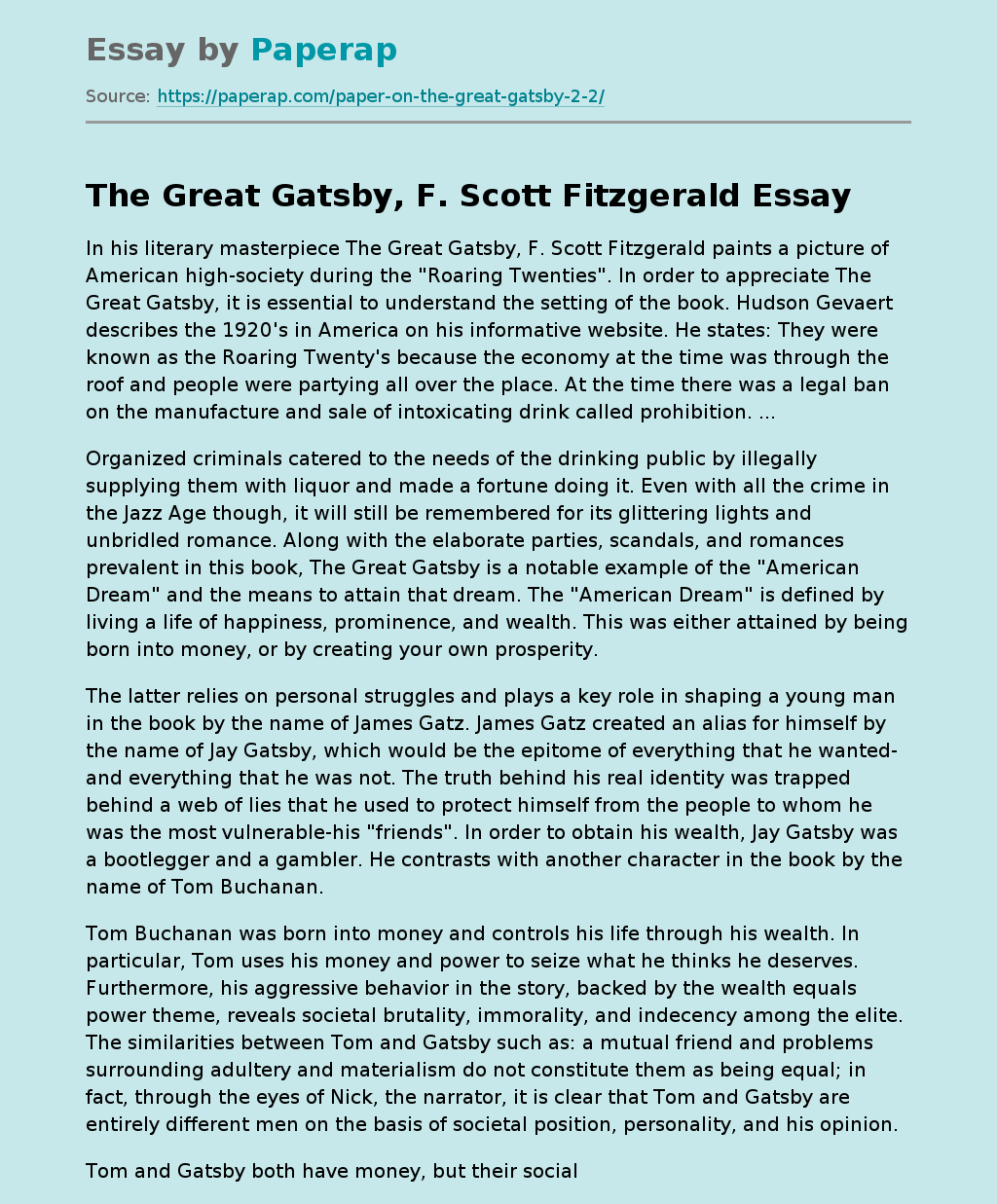The Great Gatsby Portraying 1920s High Society
In his literary masterpiece The Great Gatsby, F. Scott Fitzgerald paints a picture of American high-society during the “Roaring Twenties”. In order to appreciate The Great Gatsby, it is essential to understand the setting of the book. Hudson Gevaert describes the 1920’s in America on his informative website. He states: They were known as the Roaring Twenty’s because the economy at the time was through the roof and people were partying all over the place. At the time there was a legal ban on the manufacture and sale of intoxicating drink called prohibition.
Organized criminals catered to the needs of the drinking public by illegally supplying them with liquor and made a fortune doing it. Even with all the crime in the Jazz Age though, it will still be remembered for its glittering lights and unbridled romance. Along with the elaborate parties, scandals, and romances prevalent in this book, The Great Gatsby is a notable example of the “American Dream” and the means to attain that dream.
The “American Dream” is defined by living a life of happiness, prominence, and wealth. This was either attained by being born into money, or by creating your own prosperity.
The latter relies on personal struggles and plays a key role in shaping a young man in the book by the name of James Gatz. James Gatz created an alias for himself by the name of Jay Gatsby, which would be the epitome of everything that he wanted- and everything that he was not.
The truth behind his real identity was trapped behind a web of lies that he used to protect himself from the people to whom he was the most vulnerable-his “friends”. In order to obtain his wealth, Jay Gatsby was a bootlegger and a gambler. He contrasts with another character in the book by the name of Tom Buchanan.
Tom Buchanan was born into money and controls his life through his wealth. In particular, Tom uses his money and power to seize what he thinks he deserves. Furthermore, his aggressive behavior in the story, backed by the wealth equals power theme, reveals societal brutality, immorality, and indecency among the elite. The similarities between Tom and Gatsby such as: a mutual friend and problems surrounding adultery and materialism do not constitute them as being equal; in fact, through the eyes of Nick, the narrator, it is clear that Tom and Gatsby are entirely different men on the basis of societal position, personality, and his opinion.
Tom and Gatsby both have money, but their social statuses are not equal. The inequality of Tom and Gatsby can be seen through the book’s strongest metaphor: East Egg and West Egg. The East Egg is a secluded area in Long Island which gives homage to the “old money” of society. These untouchable few breed money and hold great amounts of influence and power. On the other side of the sea is West Egg. This area is extremely wealthy as well, but houses “new money” such as Gatsby. These people are not treated equally in upper class society because their money was not inherited.
East Egg is more elite than West Egg, and impossible for a common person to reach. Unless you were born under a wealthy name, like Tom, you can not be part of their society. Gatsby knows that it is more prestigious to be part of the East Egg society, and for that reason, he stays focused on his dream to obtain the love of Daisy, Tom’s wife. Another important difference between Gatsby and Tom is that Gatsby is a dreamer, and Tom is practical. An important metaphor in the book is a green light at the end of the Buchanan dock in East Egg, seen from Gatsby’s yard in West Egg.
It represents Daisy and a materialistic lifestyle. One night after dinner at the Buchanan’s, Tom saw Gatsby he stretched out his arms toward the dark water in a curious way, and, far as I was from him, I could have sworn he was trembling. Involuntarily I glanced seaward-and distinguished nothing except a single green light, minute and far away, that might have been the end of a dock” (Fitzgerald 28). The light represents Gatsby’s pursuit towards his rich ideal life. Gatsby came a long way from nothing to be living where he is, and he makes sure that nothing will interfere in his ultimate goal of opulence.
Nick reveals at the end of the book that “James Gatz-that was really, or at least legally, his [Gatsby’s] name. He had changed it at the age of seventeen and at the specific moment that witnessed the beginning of his career-when he saw Dan Cody’s yacht drop anchor over the most insidious flat on Lake Superior” (Fitzgerald 104). Ever since Gatsby was young, he craved a lifestyle that he never had and went as far as creating an alias to cover up his “inferior” roots. The problem with coming from a family of lower class was never a problem for Tom.
Tom Buchanan is practical in the sense that he knows that he can use money and influence to get what he wants. Tom Buchanan buys his way through life and love. Tom and his wife Daisy started out their life together in a very elaborate way. “He came down with a hundred people in four private cars, and hired a whole floor of the Muhlbach Hotel and the day before the wedding he gave her a string of pearls valued at three hundred and fifty thousand dollars (Fitzgerald 82)”.
The Great Gatsby Portraying 1920s High Society. (2018, Jan 18). Retrieved from https://paperap.com/paper-on-the-great-gatsby-2-2/

